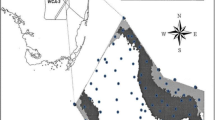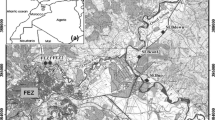Abstract
The Akaki River, laden with untreated wastes from domestic, industrial, and commercial sources, serves as a source of water for irrigating vegetable farms. The purpose of this study is to identify the impact of waste-water irrigation on the level of heavy metals and to predict their potential mobility and bioavailability. Zn and V had the highest, whereas Hg the lowest, concentrations observed in the soils. The average contents of As, Co, Cr, Cu, Ni, Zn, V, and Hg of both soils; and Pb and Se from Fluvisol surpassed the mean + 2 SD of the corresponding levels reported for their uncontaminated counterparts. Apparently, irrigation with waste water for the last few decades has contributed to the observed higher concentrations of the above elements in the study soils (Vertisol and Fluvisol) when compared to uncontaminated Vertisol and Fluvisol. On the other hand, Vertisol accommodated comparatively higher average levels of Cr, Cu, Ni, Zn, etc V, and Cd, whereas high contents of Pb and Se were observed in Fluvisol. Alternatively, comparable levels of Co and Hg were found in either soil. Except for Ni, Cr, and Cd in contaminated Vertisol, heavy metals in the soils were not significantly affected by the depth (0–20 and 30–50 cm). When the same element from the two soils was compared, the levels of Cr, Cu, Ni, Pb, Se, Zn, V, Cd at 0–20 cm; and Cr, Ni, Cu, Cd, and Zn at 30–50 cm were significantly different. Organic carbon (in both soils), CEC (Fluvisol), and clay (Vertisol) exhibited significant positive correspondences with the total heavy metal levels. Conversely, Se and Hg contents revealed perceptible associations with carbonate and pH. The exchangeable fraction was dominated by Hg and Cd, whereas the carbonate fraction was abounded with Cd, Pb, and Co. conversely, V and Pb displayed strong affinity to reducible fraction, where as Cr, Cu, Zn, and Ni dominated the oxidizable fraction. Cr, Hg, Se, and Zn (in both soils) showed preference to the residual fraction. Generally, a considerable proportion of the total levels of many of the heavy metals resided in non residual fractions. The enhanced lability is generally expected to follow the order: Cd > Co > Pb > Cu > Ni > Se > V and Pb > Cd > Co > Cu > Ni > Zn in Vertisol and Fluvisol, respectively. For the similar wastewater application, the soil variables influence the status and the distribution of the associated heavy metals among the different soil fractions in the study soils. Among heavy metals that presented relatively elevated levels and with potential mobility, Co, Cu, Ni (either soil), V (Vertisol), Pb, and Zn (Fluvisol) could pose health threat through their introduction into the food chain in the wastewater irrigated soils.


Similar content being viewed by others
References
Abollino O., M. Aceto, M. Malandrino, E. Mentasi, C. Sarazin, F. Petrella. 2002. Heavy metals in agricultural soils from Piedmont, Italy: distribution, speciation, and chemometric data treatment. Chemosphere 49:545–557
Adriano D. C. 1986. Trace elements in the terrestrial environment. Springer-Verlag, New York, 533 pp
Adriano D. C. 2001. Trace elements in the terrestrial environment. Biogeochemistry, bioavailability and risk of metals. 2nd ed. Springer-Verlag, New York, 880 pp
Ahumada I., J. Mendoza, E. Navarrete, L. Ascar. 1999. Sequential extraction of heavy metals in soils irrigated with wastewater. Commun Soil Sci Plant Anal 30 (9 & 10):1507–1519
Alloway B. J. 1995. Cadmium. In: B. J. Alloway (ed:) Heavy metal in soils. 2nd ed. Blackie Academic and Professional, pp 122–151
Alriksson A. 1998. Afforestation of farmland. Soil changes and uptake of heavy metals and nutrients by trees. PhD thesis, Swedish University of Agricultural Sciences, Uppsala, Sweden
Angelone M., C. Bini. 1992. Trace elements concentrations in soils and plants of Western Europe. In: D. C. Adriano (ed) Biogeochemistry of trace metals. Lewis Publishers. pp 19–60
Aubert H., M. Pinta. 1977. Track elements in soils. In: Development in soil science 7. Elsevier Scientific Publishing Company, pp 5–7
Baker D. E., J. P. Senft. 1995. Copper. In: B. J. Alloway (ed) Heavy metal in soils. 2nd ed. Blackie Academic and Professional, pp 11–37
Bermond A. 2001. Limits of sequential extraction procedures re-examined with emphasis on the role of H+ ion reactivity. Anal Chim Acta 445:79–88
Das A. K., R. Chakraborty, M. L. Carvera, M. Guardia. 1995. Metal Speciation in Solid Matrices. Talanta 42:1007–1030
Dahlin C. L., C. A. Williamson, W. K. Collins, D. C. Dahlin. 2002. Sequential extraction versus comprehensive characterization of heavy metal species in brownfield soils. Envir Forensics 3:191–201
Han F. X., A. Banin, Y. Su, D. L. Monts, M. J. Plodinec, W. L. Kingery, G. E. Triplett. 2002. Industrial age anthropogenic inputs of heavy metals into the pedosphere. Naturwissenschaften 89:497–504
Itanna F. 1998. Comparative study on soil pollution with toxic substances on farmlands close to old and new industrial sites in ethiopia. Bull Chem Soc Ethiopia 12(2):105–112
Itanna F., M. Olsson. 2004. Land degradation in Addis Ababa and urban development. Ethiopian J Dev Resources 26(1):77–100
Keikens L. 1995. Zinc. In: B. J. Alloway (ed) Heavy metals in soils. 2nd ed. Blackie Academic and Professional, pp 284–305
Ladonin D. V. 2002. Heavy metal compounds in soils:problems and methods of study. Eurasian Soil Sci 35(6):605–613
Lu Y., Z. Gong, G. Zhang, W. Burghardt. 2003. Concentrations and chemicals speciations of Cu, Zn, Pb, and Cr of urban soils in Nanjing, China. Geoderma 115:101–111
Ma L. O., G. N. Rao. 1997. Heavy metals in the environment. J Envir Qual 26:259–264
Ma Y. B., N. C. Uren. 1998. Transformation of heavy metals added to soil: application of a new sequential extraction procedure. Geoderma 84:157–168
Manta D. S., M. Angelone, A. Bellanca, R. Neri, M. Sporoveieri. 2002. Heavy metals in urban soils: a case study from the city of Palermo (Sicily), Italy. Sci Total Envir 300 (1–3):229–243
McBride M. B. 1994. Trace and toxic elements in soils. In: M. B. McBride. Environmental chemistry of soils. Oxford University Press, pp 308–341
McGrath S. P. 1995. Chromium and nickel. In: B. J. Alloway (ed) Heavy metal in soils. 2nd ed. Blackie Academic and Professional pp 152–178
McGrath D. 1996. Application of single and sequential extraction procedures to polluted and unpolluted soils. Sci Total Envir 178:37–44
McLean J. E., B. E. Bledsoe. 1992. Behavior of metals in soils. Ground water issue. EPA, 25 pp
Morabito R. 1995. Extraction techniques in speciation analysis of environmental samples. Fresenius J Chem 351:378–385
Morera M. T., J. C. Echeverria, C. Mazkiaran, J. J. Garrido. 2001. Isotherms and sequential extraction procedures for evaluating sorption and distribution of heavy metals in soils. Envir Pollution 113:135–144
Olajire A. A., E. T. Ayodele, G. O. Oyedirdan, E. A. Oluyemi. 2003. Levels and speciation of heavy metals in soils of industrial southern Nigeria. Envir Monit Assess 85:135–155
Pendias A. K., H. Pendias. 2001. Trace elements in soils and plants. 3rd ed. CRC Press, 413 pp
Pezzarossa B., G. Petruzzeli. 2001. Selenium contamination in soil: sorption and desorption processes. In: H. M. Selim, D. L. Spark (eds) Heavy metals release in soils. Lewis Publishers, pp 191–206
Pueyo M., J. Sastre, E. Hernandez, M. Vidal, J. F. Lopez-Sanchez, G. Rauret. 2003. Heavy metals in the environment: prediction of trace element mobility in contaminated soils by sequential extraction. J Envir Qual 32:2054–2066
Quevauviller P. 1998. Operationally defined extraction procedures for soil and sediment analysis I. Standardization. Trends Anal Chem 17:289–298
Rule J. H. 1998. Trace metal cation adsorption in soils: selective chemical extractions and biological availability. In: A. Dabrowski (ed) Adsorption and its Applications industry and environmental protection, Vol. II: applications in environmental protection. Studies in surface science and catalysis. Elsevier, pp 319–349
Sillanapaa M. 1972. Trace elements in soils and agriculture. FAO Soils Bulletin number 17. Rome
Smith K., J. E. Paterson. 1995. Manganese and cobalt. In: B. J. Alloway (ed) Heavy metal in soils. 2nd ed. Blackie Academic and Professional, pp 225–244
Stalikas C. D., G. A. Pilidis, S. M. Tzouwara-Karayanni. 1999. Use of a sequential extraction scheme with data normalization to assess the metal distribution in agricultural soils irrigated by lake water. Sci Total Envir 236(1–3):7–18
Steinnes E. 1995. Mercury. pp 245–259 In: B. J. Alloway (ed) Heavy metal in soils. 2nd ed. Blackie Academic and Professional, pp 245–259
Tack F. M. G., M. G. Verloo. 1995. Chemical speciation and fractionation in soil and sediment heavy metal analysis: a review. Int J Envir Anal Chem 59:225–238
Tessier A., P. G. C. Cambell M. Bisson. 1979. Sequential extraction procedure for the speciation of particulate trace metals. Anal Chem 51(7):844–851
Wahnschaffe F., F. Schucht. 1924. Anleitung zur wissenschafftlichen Bodenuntersuchung. Verlag von Parey, Berlin pp 53–56
Ward N. L. 1995. Trace elements. In: F. W. Fifield, P. J. Haines (eds) Environmental analytical chemistry. Blackie Academic and Professional, pp 320–351
White W. M. 2005. Tracer elements in igneous processes. In: Geochemistry, an on-line text book, Cornell University, retrieved December 2005 from http://www.geo.cornell.edu/geology/classes/chapters/chapter07.pdf
Acknowledgments
The financial support from SIDA/SAREC is highly appreciated. The authors would like to thank staff members of the ISPCSP, Departments of Forest Soil and Soil Sciences at SLU for the technical and other support rendered. We also acknowledge the valuable comments from Dr. Feleke Zewge, Bekele Lemma, Solomon Tilahun, Solomon Zewdie, and Mesfin Tekle Ab.
Author information
Authors and Affiliations
Corresponding author
Rights and permissions
About this article
Cite this article
Fitamo, D., Itana, F. & Olsson, M. Total Contents and Sequential Extraction of Heavy Metals in Soils Irrigated with Wastewater, Akaki, Ethiopia. Environmental Management 39, 178–193 (2007). https://doi.org/10.1007/s00267-006-0074-4
Received:
Accepted:
Published:
Issue Date:
DOI: https://doi.org/10.1007/s00267-006-0074-4




